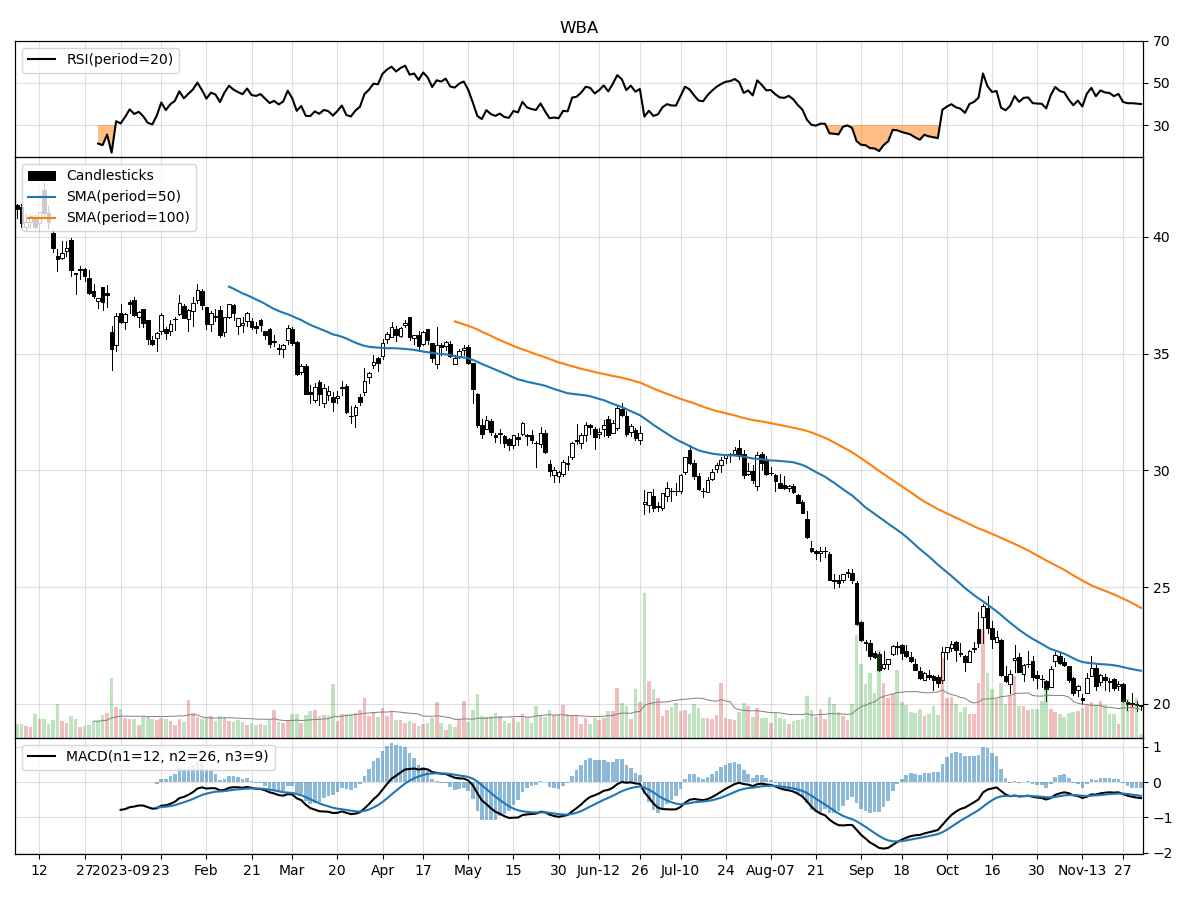Walgreens Boots Alliance(WBA), Large Cap AI Study of the Week
Walgreens Boots Alliance reported an 8.6% increase in sales, but WBA's opioid litigation settlements have led to a staggering $7.4 billion liability, weighing heavily on the company's financials.

December 1, 2023
Weekly AI Pick from the S&P 500
Walgreens Boots Alliance, Inc. (WBA)
Company Overview
Walgreens Boots Alliance, Inc. is a global leader in integrated healthcare, pharmacy, and retail, generating sales of $139.1 billion in 2023. The company operates in nine countries with over 331,000 employees and approximately 13,000 locations worldwide. Walgreens Boots Alliance is one of the world's largest purchasers of prescription drugs and offers a wide range of products and services, including pharmacy services, health and beauty products, and digital platforms for customer convenience. The company is also committed to ESG initiatives and has received accolades for its efforts.
The company operates in a highly competitive retail pharmacy industry, facing challenges such as government regulations, third-party reimbursements, eligibility criteria, and changes in law. However, it has managed these challenges by focusing on operational efficiency and cost reduction. The company foresees an opportunity for pharmacists and retail pharmacies to play a more significant role in driving positive outcomes for patients and payors through expanded service offerings and access.
Walgreens Boots Alliance, Inc. operates in three main segments: U.S. Retail Pharmacy, International, and U.S. Healthcare. In fiscal 2023, the company generated $110.3 billion in U.S. Retail Pharmacy, $22.2 billion International, and $6.6 billion in U.S. Healthcare. The company is focusing on creating a neighborhood health destination and modernizing its pharmacy in line with a wider range of healthcare services, leveraging technologies to improve health outcomes and manage costs.
Internationally, the company operates a retail health & beauty business and runs a pharmaceutical wholesaling and distribution business in Germany. However, it faces challenges such as drug reimbursement pressures, rate adjustments, generic drug competition, and global macroeconomic conditions. Despite these challenges, the company has been introducing new initiatives to drive revenue, such as credit card programs, a 90-day retail prescription drug offering, and developing relationships with commercial payers to improve market access.
In conclusion, Walgreens Boots Alliance, Inc. operates in the retail, health and wellness, and pharmaceutical wholesaling sectors. Its products range from over-the-counter drugs to beauty products, and its services include pharmaceutical wholesaling and distribution, and health and wellness services. The company is expanding into digital healthcare and telemedicine, providing new sources of growth. Additionally, its increased focus on ESG initiatives could lead to more sustainable business practices and drive long-term growth.
By the Numbers
Annual 10-K Report Summary:
- Net loss for fiscal year 2023: $3.1 billion
- Net earnings for fiscal year 2022: $4.3 billion
- Operating loss for fiscal year 2023: $6.9 billion
- Operating income for fiscal year 2022: $1.4 billion
- Adjusted net earnings for fiscal year 2023: $3.4 billion
- Adjusted net earnings for fiscal year 2022: $4.3 billion
- U.S. Retail Pharmacy sales for fiscal year 2023: $110 billion
- U.S. Retail Pharmacy sales for fiscal year 2022: $109 billion
- Selling, general, and administrative expenses for fiscal year 2023: $27 billion
- Selling, general, and administrative expenses for fiscal year 2022: $21 billion
- Number of prescriptions for fiscal year 2023: 800.8 million
- Number of prescriptions for fiscal year 2022: 819.6 million
- Number of U.S. locations end of fiscal year 2023: 8,720
- Number of U.S. locations end of fiscal year 2022: 8,901
- International segment sales increase for fiscal year 2023: 1.7%
- International segment sales for fiscal year 2023: $22.2 billion
- Operating income for International segment fiscal year 2023: $379 million
- Operating loss for International segment fiscal year 2022: $346 million
- U.S. Healthcare segment sales for fiscal year 2023: $6.6 billion
- U.S. Healthcare segment operating loss for fiscal year 2023: $1.7 billion
Quarterly 10-Q Report Summary:
- GAAP operating loss for Q3 2023: $477 million
- Adjusted operating income for Q3 2023: $959 million
- Sales for Q3 2023: $35.415 billion
- Adjusted diluted net earnings per share for Q3 2023: $1.00
- Adjusted diluted net earnings per share for Q3 2022: $0.96
- Net earnings for Q3 2023: $118 million
- Net earnings for Q3 2022: $289 million
- Net loss for nine months ended May 31, 2023: $2.9 billion
- Net earnings for nine months ended May 31, 2022: $4.8 billion
- Sales increase for three months ending May 31, 2023: 8.6%
- Sales increase for nine months ending May 31, 2023: 0.3%
- Gross profit decrease for three months ending May 31, 2023: 3.1%
- Gross profit decrease for nine months ending May 31, 2023: 7.1%
- Operating income for three months ending May 31, 2023: $395 million
- Operating loss for nine months ending May 31, 2023: $5 billion
- Adjusted operating income decrease for nine months ending May 31, 2023: 26.1%
- International segment sales increase for three months ending May 31, 2023: 5%
- International segment sales decrease for nine months ending May 31, 2023: 1.6%
These figures highlight the financial challenges faced by WBA, including significant losses due to opioid litigation, decreased COVID-19 vaccine and testing revenues, and increased expenses in the U.S. Retail Pharmacy segment. The company is also undergoing a transformation with cost savings initiatives and strategic acquisitions.
Stock Performance and Technical Analysis

As a stock analyst looking at the provided technical data for the stock in question, we have several key indicators to consider. The stock price being 0 percent above its 52-week low and 52 percent below its 52-week high suggests that the stock is currently trading closer to the lower end of its yearly range. This could indicate that the stock is undervalued or that it has not been performing well, depending on the broader market conditions and company-specific news. The fact that the price has remained relatively stable over the last month and the last three months can be interpreted as a lack of significant momentum or catalysts in either direction, which could imply a period of consolidation.
The daily volume metrics show recent trading volume is slightly above the longer-term average. This uptick in volume might suggest a growing interest in the stock, but without a corresponding increase in stock price, it could also imply that there is increased supply without enough demand to drive the price higher. The Money Flow indicators and the note that the stock is under moderate selling pressure and distribution support this theory, as they suggest that more investors are looking to sell the stock than buy it. This could be a sign of bearish sentiment in the market for this particular stock.
Lastly, the MACD (Moving Average Convergence Divergence) being bearish at -0.38 is a technical signal that the short-term momentum is weaker than the long-term momentum, indicating a potential downward trend in price. The MACD is a trend-following momentum indicator that shows the relationship between two moving averages of a stock's price, and a negative value typically suggests that the bears are currently in control, potentially leading to further declines.
In conclusion, the technical analysis suggests that this stock is not showing signs of strong bullish momentum and is currently facing selling pressure, as evidenced by the Money Flow indicators and bearish MACD. While the stability in price could be seen as a base for potential upside, the current indicators do not present a compelling case for an immediate investment based purely on technicals. An investor might look for additional fundamental analysis or potential catalysts that could drive the stock's price before deciding to invest. It's also crucial to consider overall market conditions, industry performance, and company-specific news or financial health for a more holistic analysis.

The ‘Bull’ Perspective
Investing in Walgreens Boots Alliance (WBA): A Strategic Opportunity
Summary:
- Robust Sales Growth: Walgreens Boots Alliance reported an 8.6% increase in sales, reaching $35.415 billion for the quarter ending May 31, 2023, showcasing the company's ability to grow its top-line revenue in a challenging economic landscape.
- Strategic Healthcare Investments: WBA's strategic forays into healthcare, including a 30% equity interest in Shields and a 45% stake in CareCentrix, signal a diversification that could lead to new revenue streams and a more resilient business model.
- Cost Management Success: The company's Transformational Cost Management Program has exceeded its targets, now aiming for $4.1 billion in annual savings, which demonstrates WBA's commitment to efficiency and profitability.
- International Segment Resilience: Despite global economic headwinds, WBA's International segment reported a 5% increase in sales for the quarter, indicating strong overseas market performance and potential for further growth.
- Adaptability and Market Positioning: Walgreens Boots Alliance's ability to navigate through opioid litigation, COVID-19 impacts, and supply chain challenges while still investing in growth areas like healthcare positions the company as a potentially undervalued stock with long-term upside.
Elaboration on Key Points:
- Robust Sales Growth:
Walgreens Boots Alliance's impressive 8.6% sales increase to $35.415 billion for the recent quarter is a testament to the company's robust operational execution. This growth comes in the face of widespread economic challenges and demonstrates WBA's ability to not only retain but also expand its customer base. The consistent rise in sales, despite a decrease in COVID-19 related services, underscores the underlying strength of WBA's core pharmacy and retail operations. Moreover, the adjusted diluted net earnings per common share increased from $0.96 to $1.00 year-over-year, providing further evidence of the company's profitability and sound financial management. - Strategic Healthcare Investments:
WBA's strategic investments in healthcare, such as the $1.4 billion acquisition of a 30% equity interest in Shields and a 45% stake in CareCentrix for $378 million, highlight the company's forward-thinking approach. These investments diversify WBA's revenue sources, reducing reliance on traditional retail and pharmacy operations. The move into healthcare services is a strong play, capitalizing on the growing demand for integrated care and potentially driving future earnings growth. With the healthcare industry evolving rapidly, WBA's positioning could yield significant returns as these investments mature. - Cost Management Success:
The Transformational Cost Management Program's success in raising the annual cost savings target from $3.5 billion to $4.1 billion is a clear indicator of WBA's operational excellence. The closure of underperforming stores, both in the UK and the U.S., reflects a strategic focus on profitability and efficiency. By streamlining operations and reducing overhead, WBA is better positioned to invest in high-growth areas and improve its competitive standing. Investors should take note of this disciplined approach to cost management, which is crucial for maintaining healthy margins in the retail and pharmacy sectors. - International Segment Resilience:
The 5% increase in international sales to $5.6 billion for the quarter signifies WBA's resilience in global markets. This performance is particularly notable given the current geopolitical tensions and economic uncertainties. The company's ability to navigate these challenges and post sales growth abroad speaks to the strength of its international brand and the effectiveness of its global strategy. As the international segment continues to recover and grow, it provides a buffer against domestic market fluctuations and contributes to the overall stability of WBA's financial profile. - Adaptability and Market Positioning:
Walgreens Boots Alliance has shown remarkable adaptability in managing the fallout from opioid litigation, the pandemic, and supply chain disruptions. The company's proactive measures, including divestitures and strategic investments, have allowed it to mitigate these risks and position itself for future growth. The recent sell-off of shares in AmerisourceBergen for $3.084 billion and the planned exit from Farmacias Ahumada in Chile are examples of WBA's active portfolio management. These moves, along with the company's established market presence, make WBA an attractive investment for those looking for a company with a strong brand, diversified offerings, and the agility to navigate a complex healthcare landscape.

The ‘Bear’ Perspective
Why Investors Should Steer Clear of Walgreens Boots Alliance (WBA) Stock
Summary:
- Substantial Legal Liabilities: WBA's opioid litigation settlements have led to a staggering $7.4 billion liability, weighing heavily on the company's financials.
- Declining Profitability: Recent financial reports show a GAAP operating loss of $477 million and a net loss of $2.9 billion for the nine months ended May 31, 2023.
- Risky Healthcare Ventures: WBA's investments in healthcare are uncertain and could potentially not provide the expected returns, given the $1.4 billion equity interest in Shields and a 45% equity interest in CareCentrix.
- Operational Challenges: The company is facing increasing pressure on gross profit margins and sales, with an 8.6% increase in sales overshadowed by a 7.1% decrease in gross profit over nine months.
- External Risk Factors: WBA is vulnerable to a multitude of risks, including economic downturns, supply chain disruptions, and regulatory changes, which could further destabilize its already precarious position.
Elaboration on Key Points:
- Substantial Legal Liabilities
The $7.4 billion opioid litigation liability is a massive financial burden for Walgreens Boots Alliance. This figure is not just a reflection of past actions but an ominous indicator of potential future liabilities and settlements that could arise. Such a significant liability restricts the company's ability to allocate capital towards growth initiatives and debt reduction. It also casts a long shadow over the stock, as investors are generally wary of companies with ongoing legal challenges that can result in unpredictable expenses and negative publicity. - Declining Profitability
Walgreens Boots Alliance's recent GAAP operating loss of $477 million is a sharp decline from previous performance, and the net loss of $2.9 billion for the nine months is alarming. These figures are indicative of underlying issues within the company's core operations, including reduced COVID-19 vaccination and testing volumes, which had previously bolstered revenues. The decline in profitability is concerning for investors looking for stable or growing earnings, and it suggests that the company's turnaround strategies may not be as effective as hoped. - Risky Healthcare Ventures
WBA's foray into healthcare, including the acquisition of equity interests in Shields and CareCentrix, represents a strategic pivot that carries considerable risk. The healthcare sector is highly competitive and subject to complex regulations, making returns on these investments uncertain. The company's debt level, exacerbated by these ventures, could strain its financial flexibility, especially if these healthcare investments do not perform as expected. - Operational Challenges
The contrast between the 8.6% increase in sales and the 7.1% decrease in gross profit over nine months is a red flag. It indicates that while WBA is generating more revenue, it's becoming less profitable—a trend that is unsustainable in the long term. The closure of hundreds of stores in the UK and the US as part of its Transformational Cost Management Program may lead to short-term savings but could also signal deeper strategic issues, such as an inability to compete effectively in certain markets or adapt to changing consumer behaviors. - External Risk Factors
Walgreens Boots Alliance's exposure to a wide array of external risks, including economic downturns, global supply chain disruptions, and regulatory changes, adds layers of uncertainty to its stock. These factors can have a direct impact on the company's operations and profitability. For instance, supply chain issues can lead to increased costs and inventory shortages, while regulatory changes can lead to increased compliance costs or fines. Economic downturns can also lead to decreased consumer spending on discretionary items, which would impact WBA's retail sales.
In conclusion, while Walgreens Boots Alliance is a well-known name in the retail pharmacy sector, the company is currently facing significant challenges that make its stock a risky investment. With substantial legal liabilities, declining profitability, risky healthcare ventures, operational challenges, and a host of external risk factors, investors should exercise caution and consider looking for more stable opportunities in the current market.




Comments ()